Campfire Audio Andromeda 2020 Review: The Hi-Fi Experience

Review written by @Fc-Construct
Introduction
If you’re familiar with the IEM scene or have ever done a bit of research into what the top “hi-fi” IEMs are, the Campfire Audio Andromeda is likely no stranger to you. Even back when I first got into IEMs 4 years ago, the Andromeda was a name that kept appearing over and over again whenever I entertained the idea of how I would upgrade to hi-fi. And for good reason: at $1,100, the CFA Andromeda represents a benchmark of sorts as it remains the most well-reviewed of all the kilobuck IEMs. When I had a chance to listen to the Andromeda at a local meet a couple years ago, I was not impressed. But here I am with the 5-BA Andromeda 2020 for what I hope will be a redemption arc. Let’s see if the Campfire Audio Andromeda will live up to its lofty reputation in its most recent reiteration.
Note: I will refer to the Andromeda 2020 as just the Andromeda for this review unless I’m doing a direct comparison to the original 2016 version.

What’s in the Box?
The unboxing experience of the Andromeda is quite something. Break the gold seal on the bottom of the box and the outer layer practically blossoms open. Inside lies a cardboard box decorated with a reflective Campfire Audio logo. Regardless of how the Andromeda sounds, I can definitely say this is one heck of a premium unboxing experience. And the luxury doesn’t stop there. Included in the box is a treasure trove of accessories.
-
Campfire Audio’s cork-based, fleece-lined carrying case. I like it. It’s on the large size but is practical and feels nice in the hand. Not easily pocketable though due to its bulk.
-
A standard IEM cleaning brush and a CFA lapel pin.
-
A dual compartment pouch for protecting the IEM shells. This prevents the shells from knocking against each other during storage and scratching themselves up.
-
Lots of tips. 3 sets of foam tips, 3 sets of silicon tips, and 5 sets of Final Audio tips in all their different sizes. For this review, I am using the Final M size tips.
-
An MMCX cable with a L-shaped jack and pre-molded ear hooks. Campfire calls it a Litz cable with Beryllium Copper MMCX plugs. I like it. It’s lightweight to the point like you don’t even feel it. There’s a bit of cable noise during use and some persistent cable memory. The Beryllium MMCX plugs are worth noting. They match the Andromeda’s own Beryllium MMCX jacks and slot in securely. The quality of the fit is leagues above the experience you get from the vast majority of other MMCX-based IEMs. The only other IEMs I can think of that has this quality of MMCX fit is Sony’s IER M7, M9, and Z1R.
The build of the Andromeda is equally premium feeling. Anodized in a captivating emerald green, each shell is built out of a finely machined aluminum that feels substantial in hand. That said however, it is a known issue that the paint chips on Campfire Audio’s products, hence the reason for the included protective shell pouch. These shells will absolutely get worn down over time, losing their green lustre. This is supposedly by choice as their designer believes that a well-loved, weathered look adds to the aesthetics of it. Personally, I disagree and am terrified of scuffing up this loaner unit.
The nozzle is rather short and on the large side at 6 mm. That said, I find the Andromeda to be one of the most comfortable IEMs I’ve tried. Once I put them on, they practically disappeared except for the tight seal of the IEM. Definitely something you have in for hours on end without noticing. Isolation is also quite good. For low level noise like in a library or office, you likely won’t hear anything once music is playing.
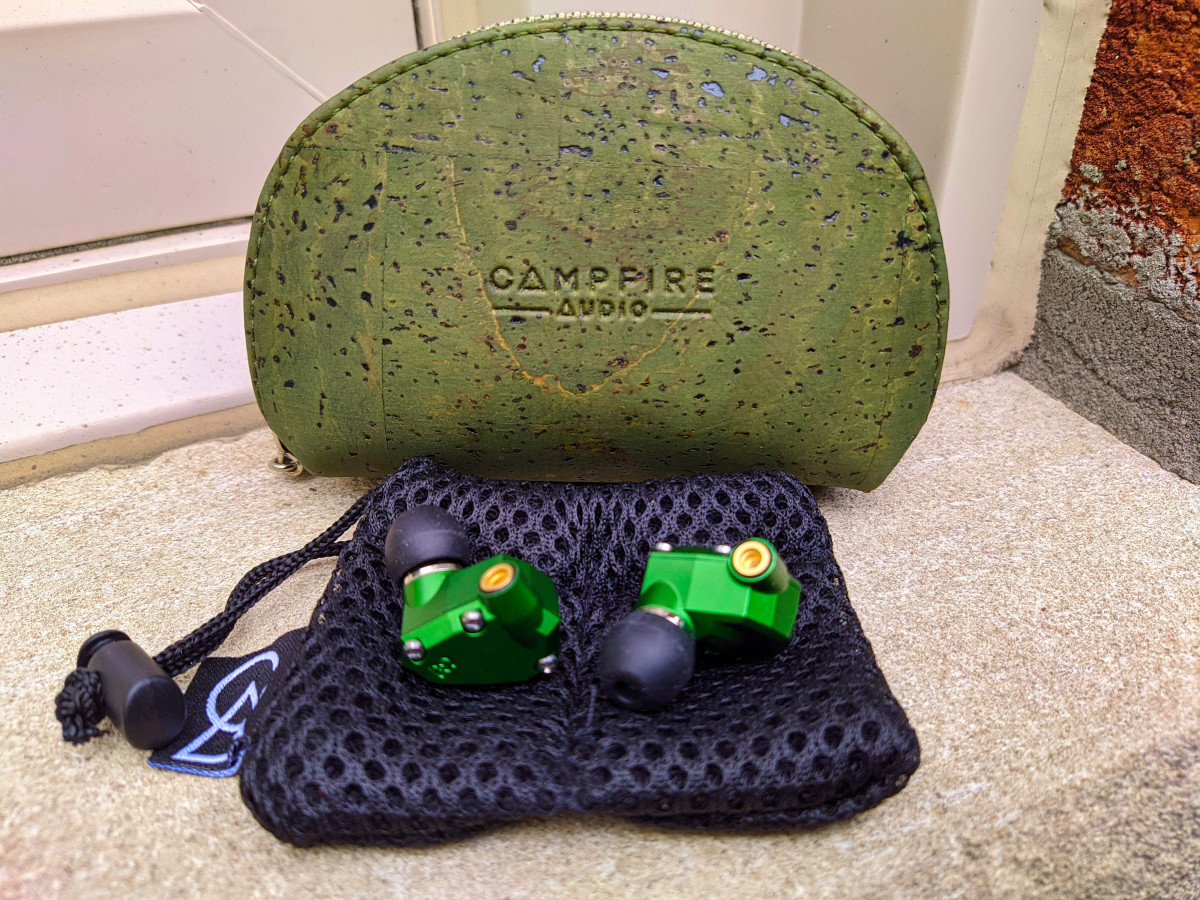
Sound
The Andromeda is famous for its soundstage and imaging. From my first listen of this IEM, I can safely say that it doesn’t disappoint. Staging is outstanding with a unique presentation compared to all other IEMs I’ve heard. The tuning of the Andromeda is best described as warm-neutral with a splash of treble brilliance. However, the other key variables I look for such as resolution, dynamics, and timbre, aren’t nearly as standout. It performs extremely well as an IEM for easy listening while working in an office. The Andromeda has a very mature sound with a coherent and refined presentation that scales nicely with better recordings. That said, it wouldn’t be my first choice for an exciting IEM to immerse myself in music with.
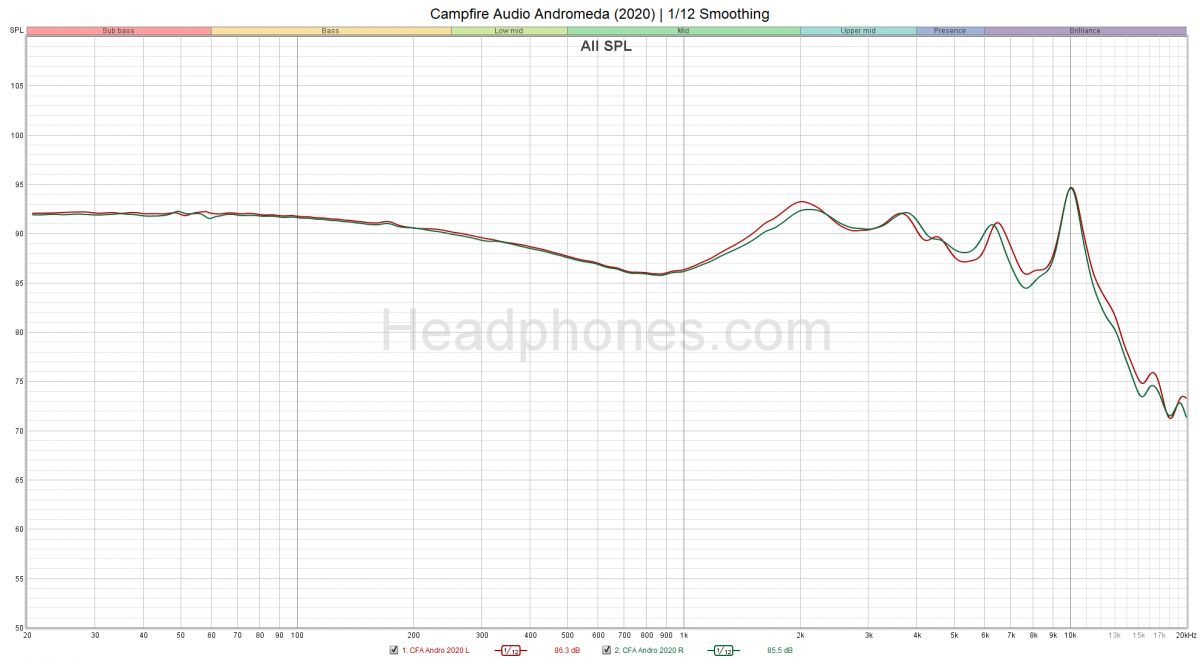
Frequency response of the Campfire Audio Andromeda 2020. Measurement taken with an IEC-711 clone microphone. Comparisons can only be made to other measurements taken by this specific microphone. The peak at about 8-9 kHz is an artifact of the microphone. It likely does not actually exist as depicted here.
One disclaimer with the Campfire Andromeda is that they are extremely sensitive to power and output impedance. For simplicity, what this means is that they may hiss on certain outputs. More importantly, their frequency response may change significantly depending on your source’s output impedance. For reference, this review will be conducted through the Apple USB-C dongle has an output impedance of < 1 Ohm. I don’t hear any hissing with this set-up and the frequency response graph above is based on this output.
Bass
Unfortunately, I’ll be starting the sound analysis of this review by saying that the bass of the Andromeda is frankly not that great. From a quantity perspective, the volume of bass strikes a nice balance where bass presence is full and never lacking yet not overbearing. The Andromeda’s subbass extends down to the lowest octaves and upper bass crosses intentionally into the lower mids. In this manner, there isn’t a particular emphasis on any part of the bass. However it is the quality of the bass that I am less impressed by. Simply put, I’m not engaged by it. Bass impact is soft where the depth of the note sounds cushioned, especially for deep drum notes. As such, the bass isn’t boomy. But neither is it punchy. It doesn’t have as tight a note definition that I generally associate with punchiness. The timbre of the bass isn’t too bad on the Andromeda. While it does still sound fairly BA-like, there is a longer decay than expected, alleviating some of the “dryness” commonly associated with BA bass. It isn’t sterile or incisive like some other BA sets are. The bass dynamics of the Andromeda are fairly flat to me. Don’t get me wrong, it’s not like the bass of the Andromeda makes it unenjoyable or anything. It’s just that it doesn’t meet my threshold for great bass.
Mids
The mids of the Andromeda 2020 was the region I was most curious about. When I demo’d the original Andromeda back a few years ago, I found that the upper mids were overly recessed such that vocals were buried and the lower mids were plagued with bass bloat. But with the Andromeda 2020, the experience is much better. The upper mids has been elevated compared to the original Andromeda to a level such that vocals have clarity and aren’t totally buried. Perhaps in some rock/metal tracks where the vocals mixing isn’t as clean you might run into a bit of a problem, but as a whole, it’s a non-issue. As a result of the increased upper mids balance, the low mids don’t sound as bloated either, despite the bass crossing straight into the mids.
On the instruments side, the Andromeda has a good warm-neutral tonality. And when I say neutral, I do mean neutral. I don’t find the Andromeda’s mids to be “lush” despite its abundance of lower mids. Acoustic guitars don’t have the level richness and depth in its tone to qualify as being lush to me. It’s just… neutral. And warm. In fact, a tad too warm for my preferences. For example, the explosive crack of the snare is partially masked by its warmth while male vocals and electric guitars could use an edge to their tone. But if you know you want something warm and easy to listen to in the mids, the Andromeda’s have got you covered.
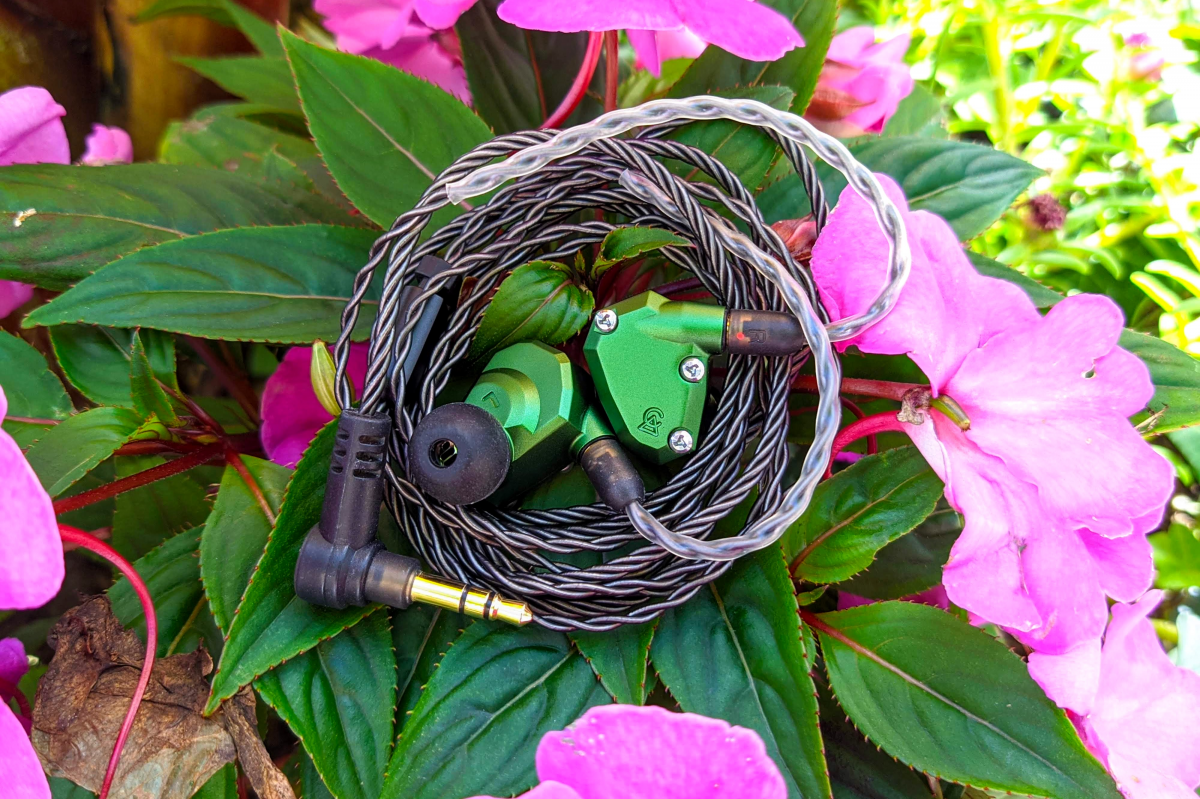
Treble
From a tuning perspective, the treble tuning of the Andromeda is the star of the show. First, the downside. It has a few peaks in the treble that pepper the high frequencies. Depending on your sensitivities, this may lead to some sibilance in vocals. Yet it is these same peaks that make the Andromeda’s treble special. They accentuate treble notes in a way that makes hats and cymbals pop out of the background. It does this in a refined and tactful manner that is never harsh to my ears. I find the Andromeda to be sparkly but not airy. The difference here is that the attack of notes are accented but the delicate, shimmering decay of cymbals and breathiness of vocals aren’t particularly highlighted. As such, though the lower and mid treble imparts great note definition in the form of emphasized upper harmonics, I don’t notice the upper treble “air region” extension of the Andromeda as much.
Presentation:
The staging of the Andromeda is its most acclaimed feature. The width and depth afforded on the Andromeda are a class above the vast majority of other IEMs. To give an analogy, regular IEMs would be like if you stood in front of your typical 4-piece rock band on a small platform at your local bar. The Andromeda would be like a standing in the middle of an orchestra pit. It’s a significant upgrade in the perception of spaciousness in how instruments play around each other. More than that is how confident and nuanced the imaging of the Andromeda is. Note don’t sound like they cluster in left, right, center blobs. Every point of the soundstage is fair game for instruments to position around. The pronounced body of each note thanks to the Andromeda’s moderate pinna gain goes a long way towards allowing instruments to anchor and be well defined in space. The cherry on top is the Andromeda’s instrument separation and layering. It exploits the depth of the soundstage to create a 3D like effect where notes may play on top of each other while having their own separate stage to express themselves. It does all of this seamlessly to provide a coherent and mature sound.
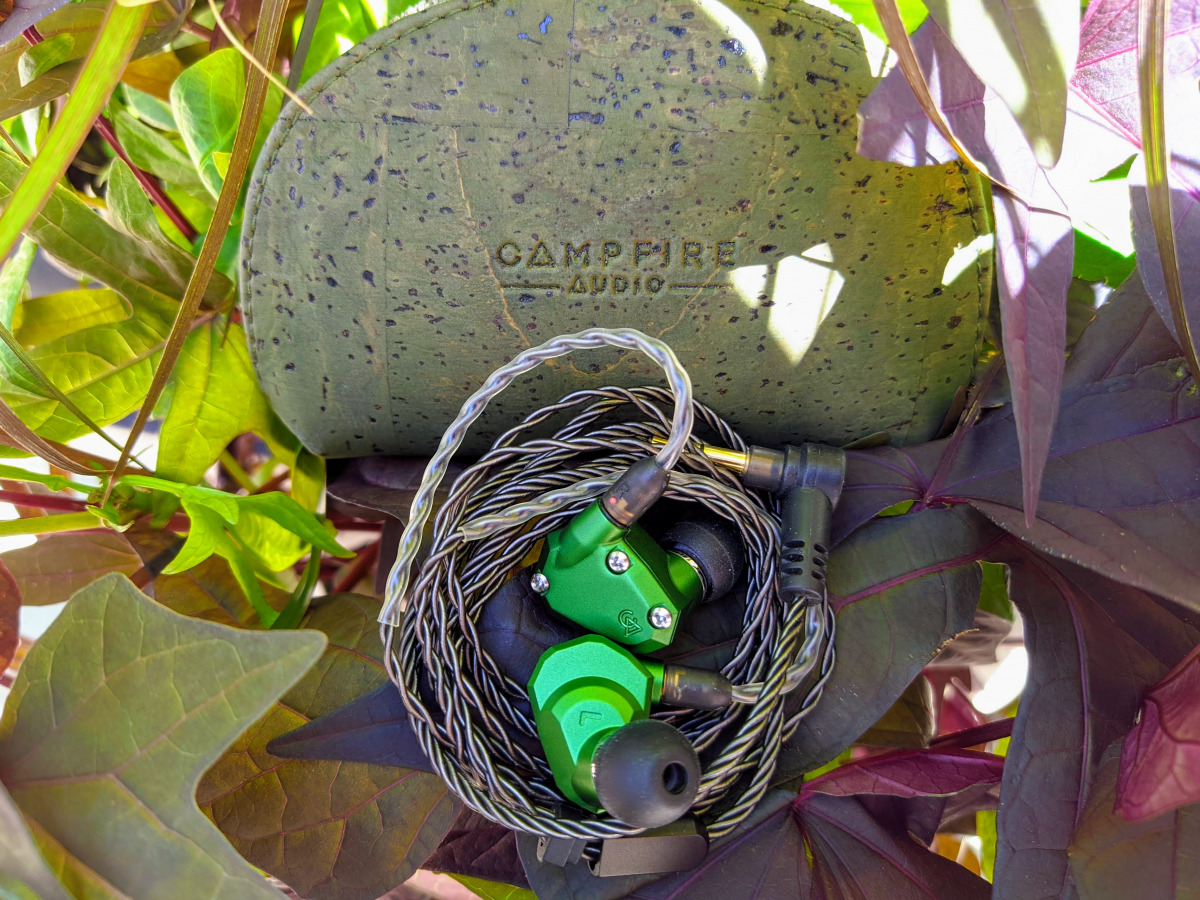
All that being said, there are a couple of important caveats to mention. First, despite how impressively large the soundstage of the Andromeda is, it isn’t out-of-your-head good, nor is it “holographic”. I would reserve those terms for a good binaural recording. Needless to say, it’s nowhere near as large as a decent open back headphone. The Andromeda is ultimately still an IEM and suffers from the same limitations when it comes to staging. It just manages these limitations much better than most. Second is the fact that the majority of soundstage and imaging qualities come from your music. IEMs can tease them out in so far as they actually exist. As such, I think the Andromeda works best for certain genres and worse than others. Metal and modern rock often don’t make good use of the Andromeda’s strengths in staging and layering while well produced pop, instrumentals, and classic rock sound excellent.
In terms of dynamics, the Andromeda does adequately for itself as an all-BA IEM. Nothing to write home about. Resolution is excellent but not to the next level when coming from mid-fi like you would expect when crossing the thousand-dollar threshold.
Comparison to the Sony MDR-EX1000
The EX1000 is another IEM known primarily for its soundstage. Compared to the Andromeda, it has a more width but less depth and layering. The difference between the two is that the EX1000 sounds very open due its large vent in the back. The Andromeda sounds expansive but not open as it seals tightly like a traditional IEM does. This results in the EX1000 having a diffusive sort of imaging where positional cues are spread out and blur off into the background. The Andromeda’s confident imaging allows to be exceptionally spacious while still having notes be clearly defined. I prefer the Andromeda’s staging but do enjoy the EX1000’s openness. Resolution and note separation go to the Andromeda. Where the EX1000 does come out on firmly top is in its dynamism and note texture.
Comparison to the MoonDrop Blessing 2 Dusk
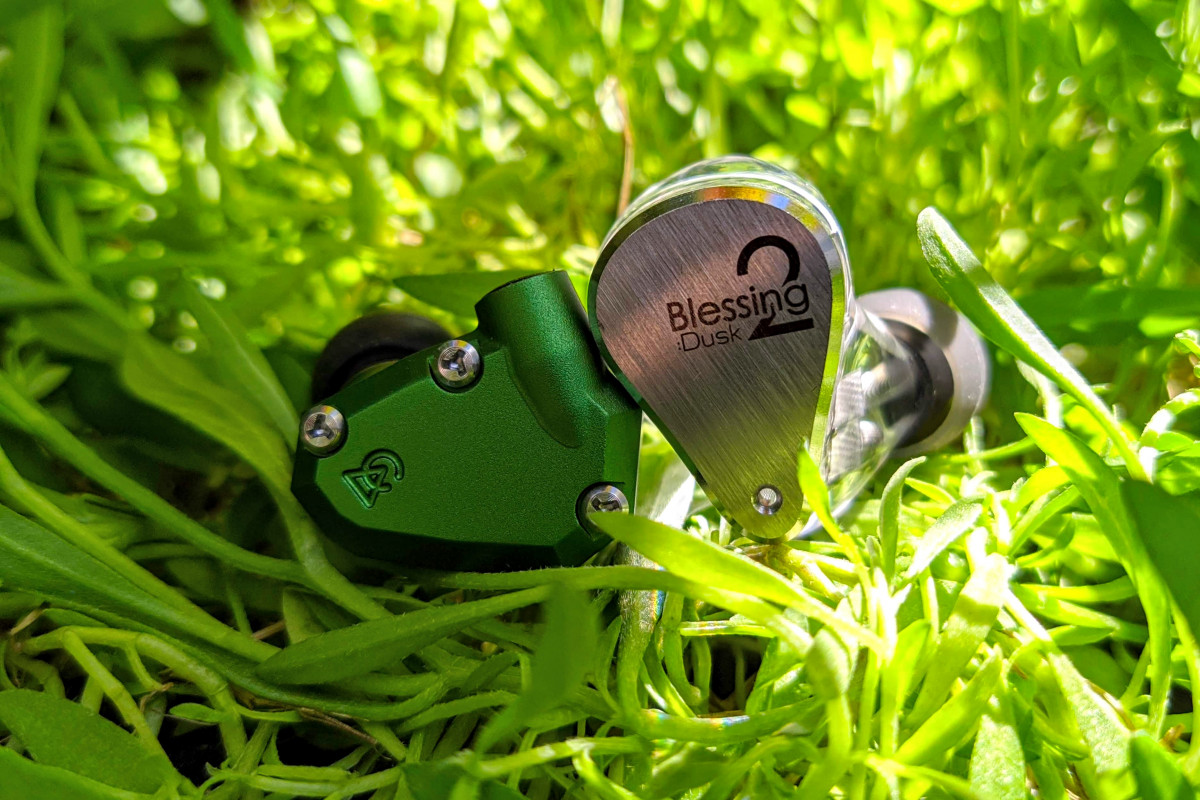
If you’re looking at the Andromeda as an upgrade to the Dusk I would first ask if you’re willing to give up the Dusk’s tuning. I think the tuning of the Dusk is quite a bit better than the Andromeda but this is a question of preference. But to be honest, once you listen to the Andromeda for some time and get adapted to its sound signature, I don’t think this will be much of a problem.
From a technical perspective, the Andromeda is far ahead of the Dusk in staging. Resolution on the Dusk is on par with the Andromeda except for the treble where the Andromeda maintains it treble presence while the Dusk takes a step back. Instrument separation is strong on both but the Andromeda pulls ahead as it’s able to make use of its stage depth for vastly improved layering. Bass timbre and dynamics is better on the Dusk thanks to its dynamic driver setup.
Comparison to the DUNU SA6

The Andromeda flexes on the SA6 when it comes to staging just like it did the Dusk. Resolution and instrument separation on the Andromeda is a step ahead of the SA6 and its treble sounds a lot more complete as it doesn’t have a major dip like the SA6 does. Tuning is subjectively better on the SA6. I prefer its bass/lower mids curve and upper mids balance as it lends a rich tone to its sound. Despite weaker bass dynamics, I think the Andromeda is a solid upgrade option technically to the SA6 while having an adjacent sound signature.
Comparison to the Thieaudio Monarch
These two IEMs are extremely different, and I would not consider the Andromeda to be a direct upgrade to the Monarch unless you want a complete change in sound signature. The Monarch is an energetic IEM with a thunderous subbass focus, aggressive lower treble, and middling staging. The Andromeda is practically the opposite of the Monarch in its presentation. An upgrade to the Monarch would be the Sony IER-Z1R. The Andromeda would be a great complementary IEM to the Monarch if you want a different flavor from time to time. Resolution is the only thing that they have in common.
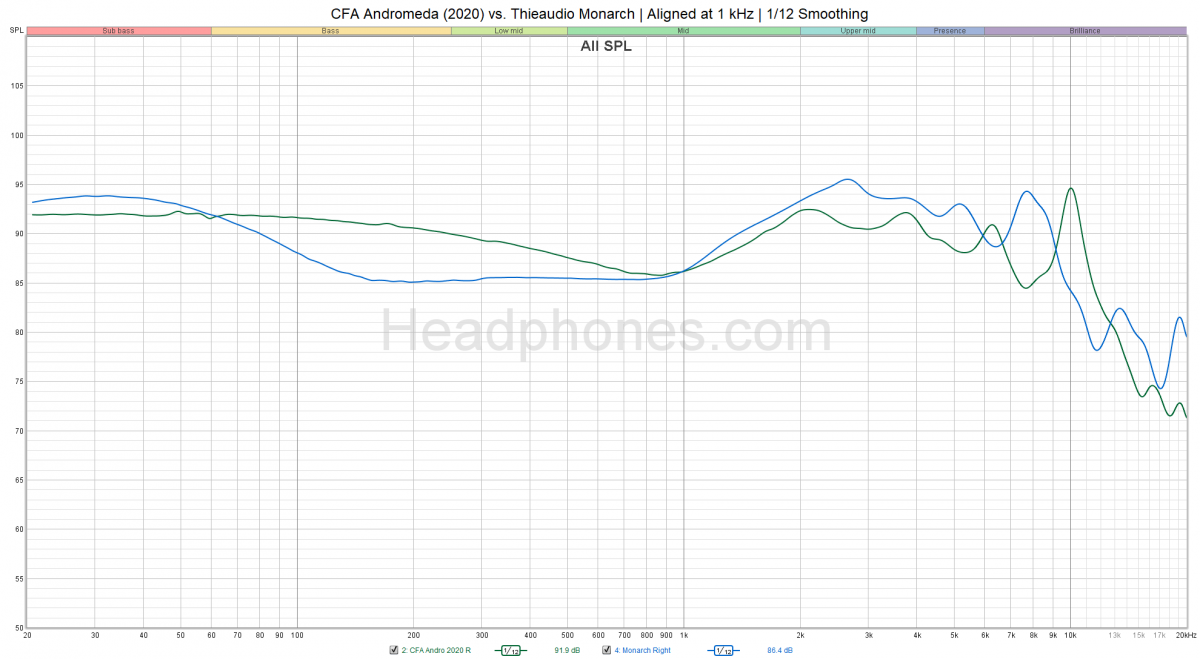
Should You Buy It?
Yes. I give the Campfire Andromeda 2020 a warm recommendation. It has an inoffensive sound signature, solid treble response, and outstanding staging. The maturity and coherency of its presentation certainly feels like listening to hi-fi. While it does have weaknesses like middling dynamics and bass quality, I think most will be able to overlook them in favour of the overall package that the Andromeda brings. If you have a healthy wallet and want a well performing, comfortable IEM for easy listening, the Andromeda nicely fits the bill.
Personally speaking, if the Andromeda was $700, it’d be very competitive in the price/performance arms race. But when you’re paying kilobuck prices, you’re paying for luxury. And part of that luxury is the question of whether or not the product brings a unique experience not found anywhere else. For the Andromeda, I would say that it does. No other IEM has the same stellar combination of soundstage, imaging, and layering. This is the Andromeda’s X-factor and is what will allow it to stand the test of time. So in that sense, one could argue that the Andromeda is in fact worth every penny. I’ll let you decide.
-FC-Construct
---
Buy the Campfire Andromeda 2020 for the best available price.
Discuss the Campfire Andromeda 2020 on the HEADPHONE Community Forum here.
---
